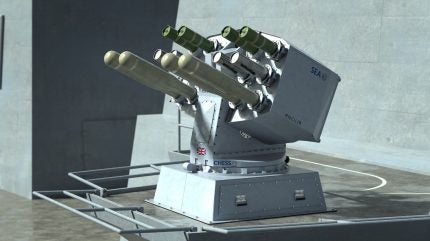
British defence solutions contractor, Systems Engineering and Assessment (Sea), a Cohort subsidiary, has gained another contract from the UK Ministry of Defence ammounting to £135m ($170.7m).
SEA will furnish UK Royal Navy vessels with its Ancilia trainable decoy launcher system, which is designed to protect ships from ballistic and hypersonic missiles by luring the threat with an alternative radar signature.
The scope of work will include the provision and support of Ancilia that also incorporates technology and hardware from Chess Dynamics, another business in the Cohort Group. Chess has also been awarded a contract to supply its Sea Eagle passive surveillance systems for Royal Australian Navy Hunter-class frigates.
Ancilia delivers effective and rapid protection against modern anti-ship threats and sophisticated systems and tactics. It will be installed across a range of the Royal Navy’s surface ships. Its design builds on SEA’s deep knowledge of existing systems in service with the Royal Navy.
SEA won a contract in 2022 to update the torpedo launcher and countermeasures systems for the Royal Navy’s Type 23 frigates, meaning that its countermeasures systems are in service across the Type 23 frigates, Royal Fleet Auxiliary, Albion, and Type 45 destroyers.
Likewise, SEA’s Torpedo Launcher System is the preferred system of the UK Royal Navy and several other navies, including in South America, Southeast Asia, and the Indo-Pacific regions.
How well do you really know your competitors?
Access the most comprehensive Company Profiles on the market, powered by GlobalData. Save hours of research. Gain competitive edge.

Thank you!
Your download email will arrive shortly
Not ready to buy yet? Download a free sample
We are confident about the unique quality of our Company Profiles. However, we want you to make the most beneficial decision for your business, so we offer a free sample that you can download by submitting the below form
By GlobalDataFacing up to advanced missile technologies
“With the speed and sophistication of missiles increasing and the window a surface platform has to respond becoming smaller, navies require the ability to rapidly and accurately deliver decoys that protect themselves against threats such as hypersonic and ballistic missiles,” stated Richard Flitton, managing director at SEA.
In recent years, several countries have directed their efforts toward the research and development and procurement of advanced next-generation conventional land attack and anti-ship missiles, featuring low radar cross-section and reduced infrared (IR) signatures, according to a GlobalData intelligence on the global missile and missile defence market.
These missiles incorporate multiple technologies, such as exhaust cooling and shaping, radar absorbent materials, IR shielding, enhanced heat dissipation, and active signature cancellation to reduce their IR signature and enhance stealth. This makes it harder for the enemy’s radar and electro-optical and infrared sensors to detect and track these missiles.
Low observable missiles enable armed forces to attack ground targets, with a reduced risk of being engaged by enemy defenses as they provide a very small detection and interception window for the enemy missile defense systems.







